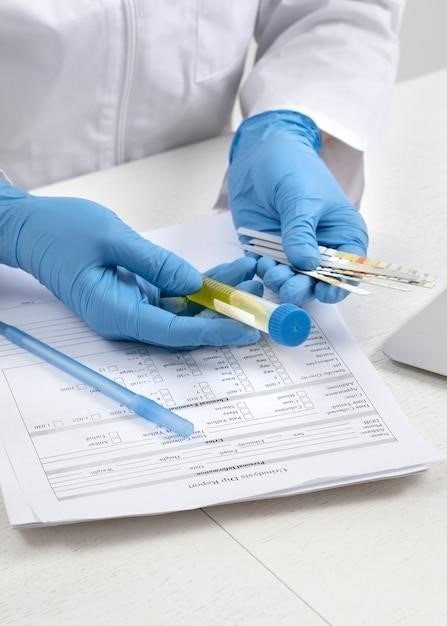AP Biology Unit 2 Test⁚ Cell Structure and Function
The AP Biology Unit 2 Test covers essential concepts related to cell structure and function. It is a challenging assessment that requires a comprehensive understanding of various cellular components, processes, and principles. To prepare effectively for this test, students should focus on key concepts like cell organelles, membrane transport, and energy production. Numerous resources are available online, including practice tests, quizzes, and study guides. These materials can help students solidify their understanding of the subject matter and identify areas where they need further review. Additionally, it is beneficial to review past AP Biology exam questions to gain insights into the types of questions and answer formats expected on the actual test.
Overview of Unit 2
AP Biology Unit 2, titled “Cell Structure and Function,” delves into the fundamental building blocks of life – cells. This unit explores the intricate world within these microscopic structures, encompassing their diverse components, their intricate interactions, and their vital roles in maintaining life. Students will unravel the secrets of the cell’s internal machinery, examining the structure and function of organelles like the nucleus, mitochondria, chloroplasts, and endoplasmic reticulum. They will delve into the mechanisms of membrane transport, understanding how substances move across the cell membrane, regulating the internal environment and facilitating essential processes. Furthermore, the unit explores the intricate pathways of energy production within cells, examining both cellular respiration and photosynthesis, the processes that power life. This exploration encompasses the intricate interplay of molecules, enzymes, and metabolic pathways that underpin these fundamental processes.
Key Concepts Covered in the Test
The AP Biology Unit 2 Test focuses on a comprehensive understanding of cell structure and function, encompassing a range of essential concepts. Students should be proficient in identifying and describing the major organelles within eukaryotic cells, including their specific structures and functions. This includes understanding the role of the nucleus in housing genetic material, the mitochondria in energy production, the chloroplasts in photosynthesis, and the endoplasmic reticulum in protein synthesis and lipid metabolism. A thorough understanding of membrane transport mechanisms is crucial, including passive transport (diffusion, osmosis, facilitated diffusion) and active transport (sodium-potassium pump, endocytosis, exocytosis). Students should be familiar with the principles of osmosis and how it affects the movement of water across cell membranes. Furthermore, the test will assess understanding of the intricate processes of cellular respiration and photosynthesis, including the key stages, reactants, products, and their respective roles in energy production and utilization. A strong grasp of these concepts will prove invaluable for success on the AP Biology Unit 2 Test.
Practice Tests and Resources
Preparing for the AP Biology Unit 2 Test requires comprehensive practice and access to relevant resources. Several online platforms offer practice tests specifically designed to cover the content covered in this unit. These tests often include a mix of multiple-choice and free-response questions, mirroring the format of the actual AP exam. Additionally, numerous websites and educational platforms provide study guides, flashcards, and interactive simulations that delve into the key concepts of cell structure and function. These resources can be invaluable for reinforcing understanding and identifying areas that require further review. Quizlet, for instance, offers a vast collection of flashcards and practice quizzes for AP Biology, including those specifically focused on Unit 2. Utilizing these resources effectively can help students develop a strong foundation in the subject matter and build confidence for the upcoming test.
Sample Multiple Choice Questions
To gain a better understanding of the types of questions you might encounter on the AP Biology Unit 2 Test, here are a few sample multiple-choice questions that cover key concepts from this unit⁚
Which of the following organelles is responsible for the synthesis of proteins?
- A. Golgi apparatus
- B. Nucleus
- C. Ribosomes
- D. Mitochondria
What is the primary function of the plasma membrane?
- A. To provide structural support for the cell
- B. To regulate the movement of substances into and out of the cell
- C. To produce energy for the cell
- D. To store genetic information
Which type of transport requires energy to move molecules across a membrane?
- A. Passive transport
- B. Active transport
- C. Diffusion
- D. Osmosis
Which of the following is NOT a characteristic of prokaryotic cells?
- A. Lack of a nucleus
- B. Presence of ribosomes
- C. Presence of membrane-bound organelles
- D. Presence of a cell wall
What is the main difference between eukaryotic and prokaryotic cells?
- A. Eukaryotic cells have a nucleus, while prokaryotic cells do not.
- B. Prokaryotic cells are larger than eukaryotic cells.
- C. Eukaryotic cells lack ribosomes, while prokaryotic cells have them.
- D. Prokaryotic cells have a cell wall, while eukaryotic cells do not.
These sample questions provide a glimpse into the types of knowledge and understanding assessed on the AP Biology Unit 2 Test. It’s important to practice with a variety of multiple-choice questions to become familiar with the format and content.
Free Response Questions (FRQs)
The AP Biology Unit 2 Test often includes free-response questions (FRQs) that assess your ability to apply your knowledge to complex scenarios and explain biological processes in detail. These questions require more than just recalling facts; they demand a deeper understanding of the concepts and the ability to synthesize information from various sources. Here are some examples of FRQ topics that could appear on the Unit 2 Test⁚
- Compare and contrast the structure and function of mitochondria and chloroplasts. This question would require you to discuss the unique features of each organelle, their roles in energy production, and how they relate to the overall functioning of the cell.
- Explain the process of active transport, providing specific examples of how it is used in cells. You would need to describe the mechanism of active transport, discuss its importance in maintaining cellular homeostasis, and illustrate your explanation with relevant examples.
- Describe the structure and function of the cell membrane, including the role of different types of membrane proteins. This question would assess your understanding of the fluid mosaic model, the functions of various membrane components, and how the membrane contributes to the regulation of cellular processes.
- Explain the endosymbiotic theory of the origin of eukaryotic cells, providing evidence to support this theory. You would need to discuss the origins of mitochondria and chloroplasts, outlining the key features that suggest their prokaryotic ancestry and how they evolved to become integral parts of eukaryotic cells.
Preparing for FRQs involves not only understanding the concepts but also practicing writing clear, concise, and well-supported answers. It’s helpful to review past FRQs from previous AP Biology exams to gain a better understanding of the types of questions and answer expectations.
Exam Structure and Scoring

The AP Biology Unit 2 Test is typically structured to assess a broad range of concepts related to cell structure and function. The exam format might vary depending on the teacher or school, but it generally includes a combination of multiple-choice questions and free-response questions. The multiple-choice section usually comprises a significant portion of the exam, testing your knowledge of specific facts, definitions, and principles. These questions might be presented in various formats, including single-answer, multiple-answer, matching, and true/false.
Free-response questions (FRQs) are more challenging, requiring you to demonstrate your understanding of complex concepts, apply your knowledge to specific scenarios, and communicate your ideas clearly and concisely. These questions often involve analysis of data, interpretation of experimental results, and the ability to synthesize information from various sources.
The scoring of the AP Biology Unit 2 Test is usually based on a combination of multiple-choice and free-response scores. The multiple-choice questions are typically graded electronically, with each correct answer contributing to the overall score. The free-response questions are graded by trained readers who assess the clarity, accuracy, and depth of your answers. The final exam score is often converted to a score out of 5, which reflects your performance relative to other students taking the exam.
Tips for Success
Succeeding on the AP Biology Unit 2 Test requires a strategic approach to studying and test-taking. Here are some tips to help you maximize your chances of success⁚
Start Early and Stay Consistent⁚ Don’t wait until the last minute to start studying. Begin reviewing the material early and dedicate consistent study time to ensure you have ample time to master the concepts.
Review Key Concepts⁚ Focus on understanding the fundamental principles of cell structure and function, including the roles of organelles, membrane transport, and energy production.
Utilize Practice Tests and Resources⁚ Take advantage of online practice tests and quizzes to assess your understanding and identify areas where you need additional review.
Develop Strong Study Habits⁚ Create a study plan that breaks down the material into manageable chunks. Use flashcards, diagrams, and other visual aids to reinforce your learning.
Time Management is Key⁚ During the exam, allocate your time wisely. Don’t spend too much time on any one question. If you encounter a difficult question, skip it and come back to it later.
Pay Attention to Details⁚ Carefully read each question and answer choice. Look for key words and phrases that provide clues to the correct answer.
Practice Writing Free-Response Answers⁚ Familiarize yourself with the format of free-response questions and practice writing clear, concise, and well-supported answers.
Stay Calm and Focused⁚ On test day, stay calm and focused. Avoid distractions and trust in your preparation. Remember that you have the skills and knowledge to succeed.
Review Past Exams⁚ Familiarize yourself with past AP Biology exam questions to gain insights into the types of questions and answer formats expected on the actual test.
Seek Help When Needed⁚ If you are struggling with certain concepts or need clarification, don’t hesitate to ask your teacher, classmates, or a tutor for help.
Study Strategies
Effective study strategies are crucial for mastering the content covered in the AP Biology Unit 2 Test. Here are some proven strategies to help you learn and retain the information⁚
Active Recall⁚ Instead of simply rereading notes or textbooks, actively recall information from memory. Use flashcards, practice quizzes, or create your own study guides to test your knowledge.
Spaced Repetition⁚ Don’t cram all your studying into one session. Break down the material into smaller chunks and review it at spaced intervals. This helps solidify the information in your long-term memory.
Concept Mapping⁚ Create visual representations of the concepts you’re learning. Concept maps use diagrams, arrows, and keywords to connect ideas and relationships, making the material more understandable and memorable.
Visual Learning⁚ Utilize visual learning aids like diagrams, flowcharts, and videos to complement your text-based study materials. Visuals can help you understand complex processes and remember key concepts.
Teach Someone Else⁚ Explaining a concept to someone else forces you to think deeply about the material and helps you identify any areas where your understanding is weak.
Practice Past Exam Questions⁚ Working through past AP Biology exam questions is an excellent way to familiarize yourself with the format, difficulty level, and types of questions you can expect on the actual test.
Seek Out Real-World Connections⁚ Connect the concepts you’re learning to real-world examples and scenarios. This will help you see how the material applies to the natural world and make it more relevant to your understanding.
Join Study Groups⁚ Collaborate with other students to discuss concepts, review materials, and practice answering exam questions. Study groups can provide valuable support and insights.
Utilize Online Resources⁚ Take advantage of the abundance of online resources, such as Khan Academy, Quizlet, and YouTube videos, to supplement your textbook and classroom materials.
Get Enough Sleep⁚ Adequate sleep is essential for memory consolidation and cognitive function. Aim for 7-8 hours of sleep per night to ensure you’re rested and alert for your test.
Important Terms and Definitions
A strong understanding of key terms and definitions is essential for success on the AP Biology Unit 2 Test. Here are some of the most important terms to master⁚
- Cell Organelles⁚ These are the functional units within a cell, each with a specific role. Examples include the nucleus, mitochondria, chloroplasts, endoplasmic reticulum, Golgi apparatus, lysosomes, and ribosomes.
- Plasma Membrane⁚ This selectively permeable barrier encloses the cell and regulates the passage of molecules in and out.
- Cytoplasm⁚ The gel-like substance that fills the cell and contains the organelles.
- Cytoskeleton⁚ A network of protein fibers that provides structural support, helps with cell movement, and facilitates intracellular transport.
- Endomembrane System⁚ A group of interconnected organelles that work together to synthesize, modify, package, and transport proteins and lipids;
- Cellular Respiration⁚ The process by which cells break down glucose to generate ATP, the energy currency of the cell.
- Photosynthesis⁚ The process used by plants and other photosynthetic organisms to convert light energy into chemical energy in the form of glucose.
- Diffusion⁚ The movement of molecules from an area of high concentration to an area of low concentration.
- Osmosis⁚ The movement of water across a selectively permeable membrane from an area of high water concentration to an area of low water concentration.
- Active Transport⁚ The movement of molecules across a membrane against their concentration gradient, requiring energy input.
- Passive Transport⁚ The movement of molecules across a membrane down their concentration gradient, without requiring energy input.
- Endocytosis⁚ The process by which cells engulf material from the external environment.
- Exocytosis⁚ The process by which cells release material from the interior to the external environment.
- Cell Cycle⁚ The series of events that take place in a cell leading to its division and duplication.
- Mitosis⁚ The process of nuclear division that produces two identical daughter cells.
- Meiosis⁚ The process of nuclear division that produces four genetically diverse gametes (sex cells).
- Chromosomes⁚ Structures within the nucleus that carry genetic information in the form of DNA.
- Genes⁚ Segments of DNA that code for specific traits.
- Mutations⁚ Changes in the DNA sequence that can alter gene function.
- Protein Synthesis⁚ The process of making proteins from the genetic information encoded in DNA.
- Transcription⁚ The process of copying the genetic information from DNA into RNA.
- Translation⁚ The process of converting the information in RNA into a protein.
- Enzymes⁚ Biological catalysts that speed up chemical reactions within cells.
- ATP⁚ Adenosine triphosphate, the primary energy currency of cells.
- Prokaryotic Cells⁚ Simple cells that lack a nucleus and other membrane-bound organelles.
- Eukaryotic Cells⁚ Complex cells that have a nucleus and other membrane-bound organelles.
Understanding these terms and their definitions will provide you with a solid foundation for comprehending the concepts covered in the AP Biology Unit 2 Test.
Review of Cellular Processes
A thorough understanding of fundamental cellular processes is crucial for success on the AP Biology Unit 2 Test. Here are some key processes to review⁚
- Cellular Respiration⁚ This process breaks down glucose to generate ATP, the primary energy currency of cells. Key stages include glycolysis, the Krebs cycle, and oxidative phosphorylation. Understanding the role of electron carriers like NADH and FADH2, the electron transport chain, and ATP synthase is essential.
- Photosynthesis⁚ Plants and other photosynthetic organisms use this process to convert light energy into chemical energy in the form of glucose. Key stages include the light-dependent reactions and the Calvin cycle. Understanding the role of chlorophyll, the electron transport chain, and carbon fixation is important.
- Protein Synthesis⁚ This process involves the production of proteins from the genetic information encoded in DNA. Key steps include transcription (copying DNA into RNA) and translation (decoding RNA to create a protein). Understanding the role of mRNA, tRNA, ribosomes, and the genetic code is crucial.
- Membrane Transport⁚ This refers to the movement of molecules across the plasma membrane. Key concepts include diffusion, osmosis, active transport, and passive transport; Understanding the role of concentration gradients, membrane permeability, and energy requirements is essential.
- Cell Cycle⁚ This refers to the series of events that take place in a cell leading to its division and duplication. Key phases include interphase (G1, S, and G2) and mitosis (prophase, metaphase, anaphase, and telophase). Understanding the role of checkpoints and the regulation of cell division is important.
- Cell Communication⁚ Cells communicate with each other through various signaling mechanisms. Understanding the role of receptors, signal transduction pathways, and second messengers is essential.
- Cell Differentiation⁚ This process involves the specialization of cells for specific functions. Understanding the role of gene regulation and environmental cues in determining cell fate is important.
- Endocytosis and Exocytosis⁚ These processes allow cells to take in and release materials from the external environment. Understanding the mechanisms of phagocytosis, pinocytosis, and receptor-mediated endocytosis is essential.
Reviewing these cellular processes and their mechanisms will greatly enhance your understanding of the material covered in the AP Biology Unit 2 Test.




Be the first to reply